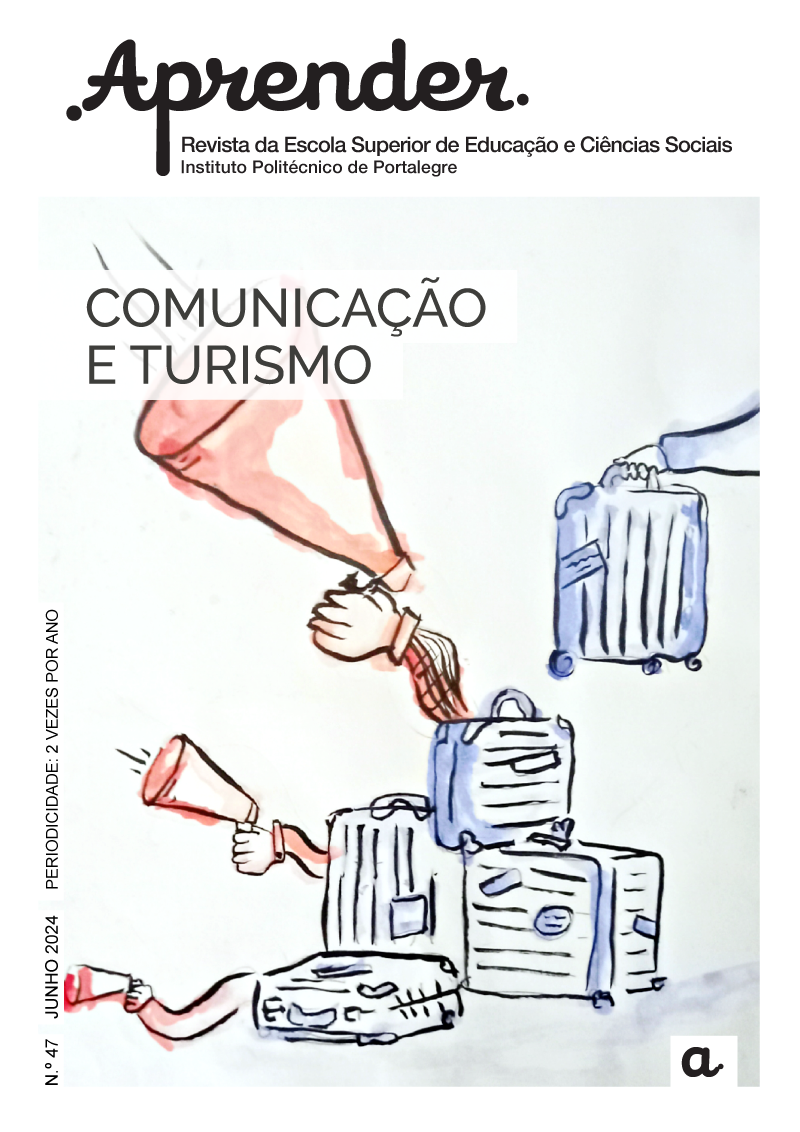From the soap opera script to the travel itinerary
an analysis of cinematographic tourism in the soap opera Fuzuê
DOI:
https://doi.org/10.58041/aprender.209Keywords:
cinematographic tourism, tourist spots, soap operaAbstract
This article proposes a reflection on the imaginaries that the soap opera Fuzuê, from the Globo network, brings in relation to the shightseeings of Rio de Janeiro. The research aims to understand how Globo presents these tourist attractions and if there is any incentive to visit these places. The analysis is mainly based on a bibliographical bias, supported by some reports collected on social networks in which the soap opera and tourist attractions are mentioned. The guiding question of the research was: "What are the imaginaries of Rio de Janeiro's tourist attractions presented in the soap opera Fuzuê?" The analysis took place in relation to three tourist attractions most shown in the soap opera, these being: Arcos da Lapa, Real Gabinete Português de Leitura and the Neighborhood of Fátima. From there, it was possible to conceive a reflection that shows that the way in which the Globo network presents these points reinforces an imaginary that is more idealistic than reality, in fact, distancing cinematographic tourism in these spaces.
References
Alencar, M. (2002). A Hollywood brasileira: panorama da telenovela no Brasil. Senac.
Barbosa, M. (2013). História da comunicação no Brasil. Editora Vozes Limitada.
Borelli, S. (2001). Telenovelas brasileiras: balanços e perspectivas. São Paulo Em Perspectiva, 15(3), 29-36. https://doi.org/10.1590/S0102-88392001000300005
Brasil. Ministério do Turismo. Turismo cultural: orientações básicas (2ª ed.). Ministério do Turismo, Secretaria Nacional de Políticas de Turismo, Departamento de Estruturação, Articulação e Ordenamento Turístico, Coordenação Geral de Segmentação.
Brasil. Ministério do Turismo. A importância da imagem para a divulgação do destino turístico. https://www.gov.br/turismo/pt-br/assuntos/noticias/a-importancia-da-imagem-para-a-divulgacao-do-destino-turistico
Brasiliana Fotográfica. (2018). Os Arcos da Lapa e os bondes de Santa Teresa. https://brasilianafotografica.bn.gov.br/?p=11127#:~:text=Foram%20inaugurados%20em%201750%2C%20durante,Alpoim%20(1700%20%E2%80%93%201765).
De Carvalho, R., & Viana, M. (2014). Somos o que consumimos: Aspectos identitários e turismo contemporâneo. Turismo: Visão e Ação, 16(3), 690. Doi: https://doi.org/10.14210/rtva.v16n3.p690-709
De Lima, A., & Da Silva, M. (2019). Telenovelas brasileiras criando imagens e imaginários turísticos: o caso do destino Rio Grande do Norte. Turismo: Visão e Ação, 21(1), 2-22. https://doi.org/10.14210/rtva.v21n1.p2-22
Duarte, R., & Fonseca Filho, A. da S. (2016). Luz, câmera... Segmentação: uma proposta de turismo cinematográfico para a cidade de Niterói-RJ. Revista Turismo em Análise, 27(2), 323 341. https://doi.org/10.11606/issn.1984-4867.v27i2p323-341
Duarte, R., Teles, A., & Filho, A. da S. F. (2020). O turismo cinematográfico pelas lentes da teoria do ator-rede. Turismo: Visão e Ação, 22(3), 485-507. https://doi.org/10.14210/rtva.v22n3.p485-507
Globo, R. (2024). Fuzuê: A novela que promete conquistar o público português. https://www.globo.com/fuzue.
Gonçalves, M. de S., & Bessone, T. (2016). The Royal Portuguese Cabinet of Reading: A space for medical science in the 19th century. Almanack (14), 241–286. https://doi.org/10.1590/2236-463320161410
Gshow. (n.d.). Bairro de Fátima, no centro do Rio de Janeiro, é cenário de Fuzuê. https://gshow.globo.com/novelas/fuzue/noticia/bairro-de-fatima-no-centro-do-rio-de-janeiro-e-cenario-de-fuzue.ghtml
Hamburger, E. (2005). O Brasil antenado: A sociedade da novela. Zahar.
Hamburger, E. (2011). Telenovelas e interpretações do Brasil. Lua Nova: Revista de Cultura e Política (82), 61-86.
Lopes, M. (2003). Telenovela brasileira: Uma narrativa sobre a nação. Comunicação & Educação (26), 17-34.
Lopes, M. (2009). Telenovela como recurso comunicativo. MATRIZes, 1(3), 21-47.
Lopes, M. (2004). Telenovela: Internacionalização e interculturalidade. Edições Loyola.
Martín-Barbero, J., & Rey, G. (2001). Os exercícios do ver: Hegemonia audiovisual e ficção televisiva. Senac.
Melo, J. (1988). As telenovelas da Globo: Produção e exportação. Summus.
Ministério do Turismo. (s.d). Glossário do turismo. http://www.dadosefatos.turismo.gov.br/gloss%C3%A1rio-do-turismo/901-t.html. Acesso em 5 de maio de 2024.
Ortiz, R., Borelli, S. H. S., & Ramos, J. M. O. (1991). Telenovela: História e produção (2ª ed.). Brasiliense.
Reimão, S. (2004). Livros e televisão: Correlações. Atelie Editorial.
Simões Borelli, S., & Melo Rocha, R. (2005). Temporalidades e territorialidades juvenis em uma metrópole brasileira. Nómadas (Col), (23), 58-67. ISSN: 0121-7550. https://www.redalyc.org/articulo.oa?id=105116741007
Downloads
Published
Issue
Section
License
Copyright (c) 2024 Giulia Goldoni

This work is licensed under a Creative Commons Attribution 4.0 International License.







